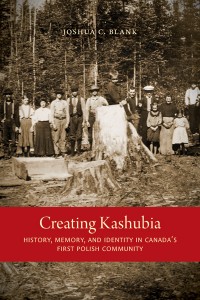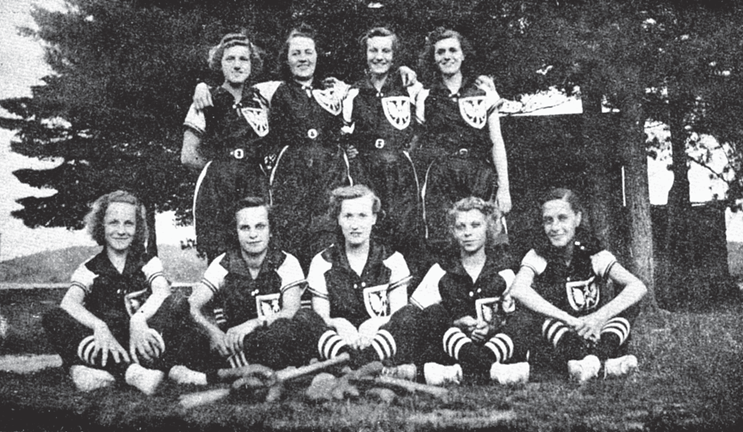Canadian Store (CAD)
You are currently shopping in our Canadian store. For orders outside of Canada, please switch to our international store. International and US orders are billed in US dollars.
Each year since 1999, on the first Saturday in May, the town of Wilno, Ontario organizes a large festival in honour of Kashub Day.
The first Kashubs to arrive in Canada settled in around Wilno, Barry’s Bay, Round Lake, Hopefield, Halfway, Shrine Hill and Rockingham in Ontario in the west end of Renfrew County. The Kashubian culture is still very rich and alive in Kaszebe Canada, and the festival is a celebration of the rich and unique Kashub culture found in the area.
If you would like to learn more about the Kashubian culture in Canada, our Spring 2016 title Creating Kashubia: History, Memory, and Identity in Canada’s First Polish Community by Joshua C. Blank is a great place to start!
From 1859 to 1876, Polish settlers along the Opeongo attended an English-speaking church in Brudenell until St Stanislaus Kostka was built in Wilno. Between 1876 and 1892, the settlers received a litany of peripatetic Polish-speaking priests, including Fr Specht, Fr Michanowski, Fr Korbutowicz, and Fr Ladislaus Dembski. From 1892 to 1928, Msgr Jankowski ministered to the local Polish settlers and their families and instructed their children in the tenets of catechism. But  the promotion of Polishness from the pulpit increased dramatically with the arrival of Fr Edward Wilowski in 1928. Wilowski was a “staunch supporter” of annual 3 May (Polish Day) celebrations until 1961, which he helped orchestrate at St Stanislaus’s and St Mary’s. For these promotions of Polish culture, Wilowski was awarded the Order of Poland in 1946. Fr Stan Kadziolka, a Kraków-born priest who was imprisoned by the Nazis in Auschwitz, Belsen, and Orienburg, arrived at the parish in 1961 and kept the Polish Day celebrations alive until his resignation in 1985. On the occasion of the 300th anniversary of Catholicism in Poland, Kadziolka helped to coordinate the events of 3 May. The St Hedwig’s choir from Barry’s Bay was enlisted to sing hymns and Polish songs. A display of Polish costumes was added with the help of Mira Jaworska – a member of the external Polish community. Kadziolka also coordinated the writing and presentation of a booklet about the Polishness of Wilno for Karol Wojtyła – Pope John Paul II – in 1984. Several kilometres west of Wilno in Barry’s Bay, Polish Day celebrations also promoted Polishness and were organized by Msgr Peter Biernacki, a descendant of original settlers who was educated in a Polish seminary in Michigan. Wilowski always extended his help to events in Barry’s Bay, too. At Biernacki’s famed and successful parish picnics, the performance of Polish culture often appeared in the picnic schedule. Advertisements in newspapers announced that Polish national songs and dances, performed by local Polish musicians and singers, were continually scheduled. The St Hedwig’s female softball team, run by Biernacki and Fr Maika, paid tribute to a Polish national symbol and was named the White Eagles.
the promotion of Polishness from the pulpit increased dramatically with the arrival of Fr Edward Wilowski in 1928. Wilowski was a “staunch supporter” of annual 3 May (Polish Day) celebrations until 1961, which he helped orchestrate at St Stanislaus’s and St Mary’s. For these promotions of Polish culture, Wilowski was awarded the Order of Poland in 1946. Fr Stan Kadziolka, a Kraków-born priest who was imprisoned by the Nazis in Auschwitz, Belsen, and Orienburg, arrived at the parish in 1961 and kept the Polish Day celebrations alive until his resignation in 1985. On the occasion of the 300th anniversary of Catholicism in Poland, Kadziolka helped to coordinate the events of 3 May. The St Hedwig’s choir from Barry’s Bay was enlisted to sing hymns and Polish songs. A display of Polish costumes was added with the help of Mira Jaworska – a member of the external Polish community. Kadziolka also coordinated the writing and presentation of a booklet about the Polishness of Wilno for Karol Wojtyła – Pope John Paul II – in 1984. Several kilometres west of Wilno in Barry’s Bay, Polish Day celebrations also promoted Polishness and were organized by Msgr Peter Biernacki, a descendant of original settlers who was educated in a Polish seminary in Michigan. Wilowski always extended his help to events in Barry’s Bay, too. At Biernacki’s famed and successful parish picnics, the performance of Polish culture often appeared in the picnic schedule. Advertisements in newspapers announced that Polish national songs and dances, performed by local Polish musicians and singers, were continually scheduled. The St Hedwig’s female softball team, run by Biernacki and Fr Maika, paid tribute to a Polish national symbol and was named the White Eagles.

The St Hedwig’s White Eagles, 1936. The team played several exhibition tilts at parish picnics in the Ottawa Valley and were coached by Msgrs Maika and Biernacki.
The celebrations surrounding 3 May were popular not only because they provided a day of leisure away from the farm or because they were a celebration of culture. They were also a celebration of a national identity and faith, which had been repressed in the homeland, and for an ethnic group were a powerful connection. As Swyripa argues, such celebrations “symbolize a vision of the nation” and are an “opposition or counter movement, anathema to the ruling regime.” For those who had experienced hardships, such as the pre- and post-Bismarckian groups and the postwar Polish priests, these celebrations reaffirmed their Polish identity and united parishioners and authority figures (both pre- and postwar immigrants) in thanksgiving and protest, solidifying knowledge of their ethnic identity.
Learn more about Creating Kashubia
More about this year’s Kashub Day Festival (May 7th 2016)
 back to all news
back to all news
No comments yet.